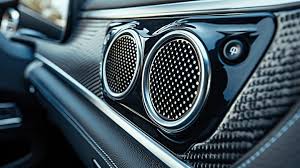
How Is the Automotive Audio System Evolving in 2030?
Share
Automotive Audio Systems Market have come a long way from bulky speakers to immersive, surface‑exciting technologies and AI‑driven sound calibration. In 2024 and beyond, carmakers and audio specialists alike are pushing boundaries—reducing weight, saving space, and delivering concert‑like experiences on the road. This blog explores three cutting‑edge developments, drawing exclusively on recent, credible sources to ensure you stay informed and inspired.
Download Your Free Sample Here
What Is a speaker less Audio System and How Does It Work?
Traditional car audio relies on discrete speakers mounted in doors and dashboards, adding weight, consuming space, and sometimes colouring sound.
How it works: Actuators mounted behind the glass display or panel excite the material, turning it into a giant speaker diaphragm.
- Key benefit: Up to 40 kg reduction in weight and space compared to conventional audio systems.
- Driver safety: Sound routed through the display localizes audio cues to onscreen alerts, improving driver attention.
Summary
The speaker less approach transforms every car surface into an immersive audio source, slashing system bulk and potentially enhancing safety by aligning sound with visual cues.
How Does Mahindra’s Sonic Studio Enhance In‑Car Audio?
According to the ET Auto Report, Mahindra’s “Sonic Studio Experience” debuted on the BE 6e and XEV 9e electric SUVs, marking India’s first Dolby Atmos‑enabled car audio system. This premium package blends hardware and artistry to deliver a studio‑quality soundscape.
- Hardware specs: A 16‑speaker, 1,400‑watt Harman Kardon system with Dolby Atmos generates three‑dimensional audio.
- Artistic collaboration: Padma Bhushan and Academy Award winner A. R. Rahman and 16‑time Grammy Award engineer Richard King crafted personalized sound elements and tuned each seat’s audio profile.
- Venues capes Live: Recreates acoustics from iconic venues—Mumbai’s Royal Opera House, Boston Symphony Hall, and Wembley Stadium—transporting passengers to global concert halls.
- Interactive audio: Cabin microphones capture live sounds (singing, talking) and weave them into the musical mix for a participatory experience.
Summary
Sonic Studio redefines in‑car entertainment by marrying cutting‑edge hardware with creative expertise, making every journey an immersive audio voyage.
What Role Does Dirac Play in Automotive Sound Calibration?
According to Audio holics Report, at CES 2025, Denon joined the Audio Foundry consortium to debut a Dirac‑enabled automotive concept system built into a Tesla Model Y. This collaboration underscores the importance of digital signal processing in overcoming cabin acoustics challenges.
- System configuration: 22 speakers and exciters—including headrest and ceiling channels—deliver immersive spatial audio on par with Denon’s home products.
- Dirac optimization: Digital correction aligns impulse responses across all transducers, removing cabin‑induced coloration and ensuring ideal loudspeaker performance.
- Up mixing technology: Dirac’s up mixing extracts spatial cues from two‑channel sources without adding new signals, preserving audio purity.
Summary
Dirac’s advanced DSP enables a cohesive, distortion‑free soundstage, turning any car into an acoustically optimized environment.
Why Is User Experience Paramount in Automotive Audio Systems?
As cars become smarter and quieter, audio systems play a critical role in brand differentiation and passenger satisfaction. Key considerations include:
- Ergonomic integration: Systems must blend seamlessly with interiors, whether via surface actuators or flush‑mount speakers.
- Adaptive sound: Real‑time correction accounts for road noise, passenger count, and cabin materials.
- Personalization: AI-driven profiles, user presets, and interactive features (e.g., ambient microphones) tailor audio to individual tastes.
- Sustainability: Lightweight materials and efficient amplifiers reduce energy draw and contribute to overall vehicle efficiency.
Summary
Next‑generation audio systems fuse form, function, and intelligence—elevating both safety and enjoyment.
Next Steps
- Evaluate cabin acoustics: Identify panels and surfaces suitable for actuator integration in upcoming vehicle designs.
- Partner with audio specialists: Collaborate with firms like Dirac or Harman Kardon early in the development cycle for tailored sound calibration.
- Incorporate spatial audio: Explore Dolby Atmos or venue‑emulation solutions to distinguish premium models.
- Leverage interactive features: Design in‑cabin microphones and algorithms for live‑mix capabilities that engage passengers.
- Balance weight and performance: Prioritize lightweight, surface‑exciting systems to optimize both sound quality and vehicle efficiency.
By embracing these innovations, automakers can craft audio experiences that resonate with tech‑savvy consumers and set new benchmarks in comfort and immersion.